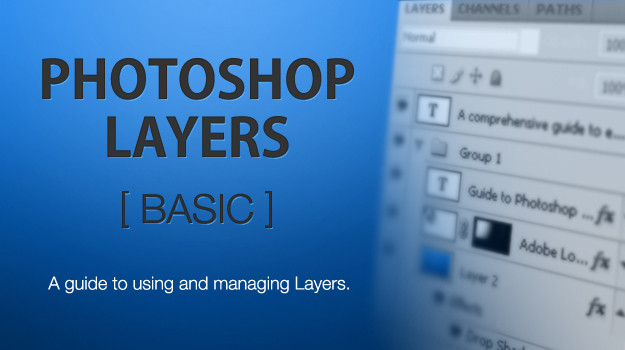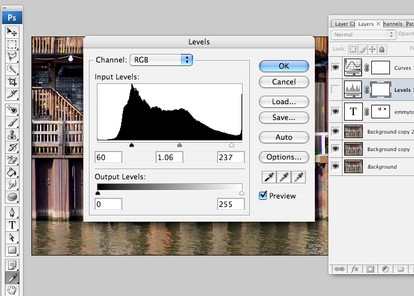HOME | DD
 nokari — Photoshop Layers: Basics
nokari — Photoshop Layers: Basics

Published: 2009-11-07 05:44:37 +0000 UTC; Views: 18321; Favourites: 264; Downloads: 3319
Redirect to original
Description
Last week I was asked by the Digital Photography instructor at my school to do some guest lectures on Photoshop. I thought it might be helpful for some students in the long run if they had some materials to read over afterwords to answer any further questions they might have, so I started putting together a simple guide.This guide is a nuts and bolts explanation of Layers and all of the options there are for creating, adjusting, and managing Layers. This includes locations of menu items, keyboard shortcuts, and explanations of different layer types.
As I said, this is a basic guide to layers, so some things have been intentionally left out. In the future, I will be uploading an advanced user guide that will go into further details and include example images.
Requires Acrobat Reader 5 or above.
Related content
Comments: 59

👍: 0 ⏩: 0






Thank you for sharing. The ratings I've given you varies a bit, so I'll cover each point separately. Please keep in mind that it's just my own, very subjective, view. If I'd critiqued solely out from the guide's purpose (printed out and read by a newbie student), I would have given it higher ratings e.deviantart.net/emoticons/s/s… " width="15" height="15" alt="


Vision
Does the artwork present or reflect a point of view, theme or idea?
I'm not quite sure how this would apply to a guide, but I've chosen to interpret it as the guide's purpose. And I think it's great that you would take the time to do the extra work to write this for the students. I'm tutoring 1st years in Mediadesign and have done quest lectures in the past, so I think I can safely say that alot of them will find this helpful. I'll certainly refer people to it and perhaps it'll save me from having to repeat myself, heh.
Originality
Is the artwork fresh or new in its style, execution or approach? Is it something you haven’t seen before in its particular genre? Does it surprise you?
I would never have thought of making a guide about layers and even if I had, I would have dismissed the idea e.deviantart.net/emoticons/l/l… " width="15" height="15" alt="

e.deviantart.net/emoticons/let… " width="15" height="15" alt="


Technique
Was the artwork skillfully created? Does the artist exhibit advanced knowledge of the medium and/or bring special focus to the craft of the medium used.
This guide is, as your other tutorial, very clean and professional looking - it could have been taken right out of any book. The first thing I looked at was what you wrote on Layer Masks, as is it one of the things I have to explain most frequently to students. Your way of explaining is good, but it would have been even clearer if you had used image(s) to illustrate. I like that you've put "(non-destructive editing)" on both layer masks and adj. layers.
There are some points which I think you could improve upon, such as:
- I sorely miss an index at the beginning of all the topics - even if it's such a short guide. It would make it so much easier to see what you cover in one glance.
- The topic titles should stand out more from the text. As it is now, the font is the same size as the main text and in bold - which would be more okay if words inside the main text wasn't highlighted the same way.
- Images. Such a promising preview; I have to admit I was a tad bit disappointed with the pdf. Even if you don't want images to clutter up the guide, you could include (perhaps on its own page) an image of the layer palette itself with arrows that pointed to all the buttons and explained what they are.
Impact
Does the artwork resonate with you or evoke strong emotions? Does it make you think? Does it blow your mind?
The reason for only e.deviantart.net/emoticons/s/s… " width="17" height="16" alt="

e.deviantart.net/emoticons/s/s… " width="17" height="16" alt="

👍: 0 ⏩: 1

Maybe I was being premature on this by uploading it. I just spent so much time on it that my brain didn't want to get into the heavy work of adding in images.
But like I said, this was a nuts and bolts guide not meant to get into details and I'll be making an advanced guide next that will include more defined information and show examples (like my previous guide).
👍: 0 ⏩: 0

Thank you Nokari. I'm a complete beginner at Photoshop, and this was really helpful.
👍: 0 ⏩: 0

In elements I was able to link layers and anything drawn on the top layer would only show up in the space in the bottom layer, how do I do this with CS5? I tried linking them but the colors go over the space I want to be coloring in.
👍: 0 ⏩: 1

I believe you're referring to a Clipping Mask. Place your cursor between the two layers you want to link, hold Alt (Option on Mac), and click. You can also find the option to make a clipping mask by going to the flyout menu of the Layers panel and select Create Clipping Mask, pressing the shortcut Control+Alt+G, or by going to Layer > Create Clipping Mask. I find the Alt+Click option to be the easiest. Here is what the result should look like: [link]
👍: 0 ⏩: 1

I think this is very amazingly written, but I still don't understand the main idea of layers and how to effectivly use them with a mouse........ Maybe it's me..........
~MP, MK, HSF1, and liz
👍: 0 ⏩: 1

I meant to cover that with my advanced tutorial, but have put it on the back burner for a while.
One thing to know is that it doesn't matter what input device you use. It can be a mouse, a tablet, whatever. You can actually do most things with nothing but keyboard shortcuts. What do you need help with?
👍: 0 ⏩: 1

O.O Wow, thank you for responding...... I never actually thought somebody would respond, expecially the creater of the tut.....
Well, I kinda don't get the idea of coloring with it. I've seen many 'how to color' tuts with the drawers coloring over things, but yet the lines stay there..... Whenever I try to use layers, it messes up...... 
~MP, MK, HSF1, and Liz
👍: 0 ⏩: 1

You know in school when a teacher would pull out the projector and use transparency sheets to draw on with markers? Layers in Photoshop are a lot like those transparency sheets. You can shuffle them around however you like and anything you put on one layer shows through all the others unless something else is put on top. Photoshop Layers can also use blending modes, which is a bit complicated to explain, but here's what you do when you want to color a lineart drawing:
1. Make a duplicate of your lineart layer (you can do this by dragging the thumbnail down to the little post-it note looking icon at the bottom of the layers palette or pressing Control-J). Hide the original lineart layer so you always have the original drawing if you ever need to go back to it.
2. At the top of the Layers palette, change the blend mode of your duplicate lineart layer to Multiply.
Create your new layers wherever you want underneath the lineart layer and do your coloring on those. Setting the lineart layer to Multiply makes only the dark colors of that layer show up on top of any layer beneath it. Since you put it on top, your lines will always be there.
👍: 0 ⏩: 1

O.O That.... That.. worked!!! What do I do after that? (what do I do with the excess paint that went over the lines?)
~MP, MK, HSF1, and Liz
👍: 0 ⏩: 1

The most basic thing to do is just use the Eraser tool.
👍: 0 ⏩: 1

To earase all that excess?? 
~MP, MK, HSF1, and Liz
👍: 0 ⏩: 1

What do you mean? I don't know what you were doing.
👍: 0 ⏩: 1

Nevermind, I completely understand Layers now XD
👍: 0 ⏩: 0

Thanks for this one. I've been using Photoshop for quite a while but learning by doing it so this kind of information helps a lot.
👍: 0 ⏩: 0

this is awesome, a must read for newbies like me
👍: 0 ⏩: 0

Thank you very much nokari, for sharing this
I work with PhotoShopElements 7,
think it will help mee too for better understanding
👍: 0 ⏩: 0

Helpful for those like me who are starting out.
👍: 0 ⏩: 0

I think this is a great tut for beginner Photoshop users they'll get a lot of use out of it.
👍: 0 ⏩: 0

You need the latest version of Adobe Reader or any alternate program that can read PDFs. You can get Adobe Reader for free from Adobe.com > Downloads.
This is a 2-page document.
Let me know if you have any other problems.
👍: 0 ⏩: 1

I got it open and it looks like a great tutorial however I am not able to use it this is sooooo frustrating kuz I know if I could FIND some one to take %min to show me what I need to know I could play with it and teach myself quite abit but that is proving harder than I thought I spent 80 bucks on a "layers" book great book but it does noy cover what I need to know. Once I DO I will want to do a tutorial with this tidbit in it for WORTHLESS MORONS like me!!!LOL I am sure that after that I will be able to use this group to it's full benefit.
👍: 0 ⏩: 1

What is it you're looking for?
I'm working an advanced guide that includes EVERYTHING about layers that's going to include 10x more information.
👍: 0 ⏩: 1

Gee ok well what I need well what I would like to be able to do is is take an object off one image and put it on another. But even the Guide for dummies assumes that you can do somethings that i cant I fear that I will have to accept the fact that I need a TUTOR kuz I cant even really explain what it is I need to know hence my rapidly increasing frustration!!!!
👍: 0 ⏩: 1

So it's basically telling you to do something but now how, right?
If you're talking about the basic act of moving one thing to another, you can do that by making a selection using any of the selection tools (lasso, polygon lasso, marquee tool, pen tool, etc.) and then copy/paste it on a layer of your choice.
I can help you better if I knew exactly what it is you're working with and what you want to do.
👍: 0 ⏩: 0

Look for the Advanced version coming soon.
👍: 0 ⏩: 0

I'm quite sure anyone who has just started using photoshop,would find this very helpful!
👍: 0 ⏩: 0

On the edit:
Yes! That's what I wanted! 
I'm happy you found the critique constructive. Keep up the good work.
👍: 0 ⏩: 0

If you click the "download" link it takes you to the pdf file.
👍: 0 ⏩: 1

You're welcome. 
Btw, I looked through your gallery and was blown away by your photography. It's all incredibly lovely.
Cheers!
👍: 0 ⏩: 1

Wow, thanks for the kind words, it's sure nice to be appreciated
👍: 0 ⏩: 0

I hope you can handle the advanced version, cause it's going to be intense.
👍: 0 ⏩: 1

Well done! 

ps: I'll post a critique from the club account later.
👍: 0 ⏩: 0
| Next =>


































